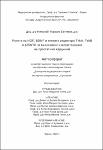Декларирам, че ще използвам предоставените материали от електронната библиотека съобразно чл.24, ал.1, т.9 от ЗАКОН ЗА АВТОРСКОТО ПРАВО И СРОДНИТЕ МУ ПРАВА единствено и само за научни, културни и образователни цели, без извличане на търговска полза, без търговски интерес и без цел печалба.Не Да

Role of NGF, BDNF and Their Receptors Trka, Trkb and P75ntr for Occurrence and Metastasis of Prostate Carcinoma // Ролята на NGF, BDNF и техните рецептори TrkA, TrkB и p75NTR за възникване и метастазиране на простатния карцином

Дата
2018Автор
Евтимов, Николай
Evtimov, Nikolay
nikolay.evtimov@mu-varna.bg
Резюме
Простатният карцином е най-честата диагноза от малигнените неоплазми сред мъжката популация. Нарушените междуклетъчните взаимодействия стоят в основата на повечето от възникналите неоплазии. В тази работа се прави опит да се представи нов възможен патоанатомичен път за възникване и метастазиране на простатният карцином.
Нерв Растежен Фактор (NGF) е първият идентифициран. Той е първият познат невротрофин, който е с доказана роля за развитието на нервната система и стимулира пролиферацията , диференциацията и клетъчната апоптоза.
Нервотрофното активиране се медиира посредством два класа рецептори, разположени върху клетката. Това са Trk рецептори и neurotrophin receptor p75 / ntr, по-късно установен, че принадлежи към групата на Tumor Necrosis Factor-receptor NGF преференциално се свързва с TrkA NGF, BDNF с TrkB BDNF. NT/3 приоритетно се свързва с Trk C, както и с TrkA & TrkB, но те са по-малко специфични. Всички невротрофини се свързват и активират с p75 ntr.
От нашето проучване доказахме, че експресията на BDNF и NGF е ограничена в областите с инвазивен карцином и значително е по-слаба в заобикалящата простатна тъкан само с хиперплазия. Подобни наблюдения подкрепят нарастващия фокус върху потискането им като терапевтична цел при КП.
Пациенти с повишена експресия на TrkA рецептори имат добра прогноза и нисък риск от развитие на метастази в по-късен етап от развитие на заболяването, а тези със силна експресия на TrkB и BDNF според нас са с лоша прогноза.
Диференцирането на изоформите на TrK рецепторите и тяхната експресия биха функционирали като прогностичен маркер за типа на диференциация на тумора. Prostate carcinoma is the most common diagnosis of malignant neoplasms among the male population. Damaged intercellular interactions form the basis of most of the malignancies. This work presents a new way for potential pathoanatomical occurrence and metastasis of prostate carcinoma. Nerve growth factor (NGF) was first identified. It is the first known neurotrophin, which has proved to have a function in the proliferation of nervous system and stimulates the proliferation, differentiation and cellular apoptosis. Neurotrophins activation is mediated by two classes of receptors located in the cell. These are Trk neurotrophin receptors and receptor p75/ntr that was later established to belong to the Tumor Necrosis Factor. Receptor-NGF preferentially binds to TrkA, and BDNF to TrkB.
The aim of this study is to establish and assess the immunohistochemical density of the expression of BDNF and NGF neurotrophins and tyrosine kinase receptors TrkA, TrkB them, p75, which regulate epithelial-stromal interactions and their fundamental role in the occurrence and progression of prostate cancer according to the stage of carcinoma in periprostate, front perirectal adipose tissue and epithelial cells in patients with prostate carcinoma.
Our study proved that the expression of BDNF and NGF is limited to areas with invasive carcinoma and is considerably weaker in the surrounding prostatic tissue hyperplasia only. Similar observations support the growing focus on suppressing them as a therapeutic target in CaP. Patients with increased expression of TrkA receptors have a good prognosis and low risk of developing metastatic disease at a later stage of the development of the disease, and those with a strong expression of BDNF and TrkB in our view have a poor prognosis. The differentiation of trkC receptor isoforms and their expression could function as a prognostic marker for tumour type differentiation.
